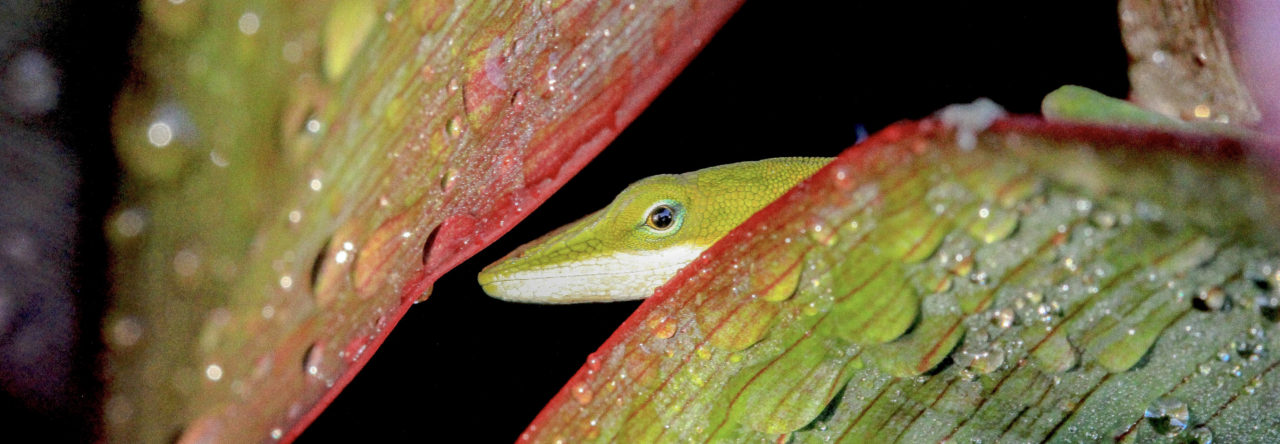I noted recently that the brown anoles here in Staniel Cay seem exceptionally skittish, and we don’t know why. Perhaps it’s a coincidence, but we’ve found a trio of three-footed lizards. What’s going on?
One team member’s hypothesis of a rare genetic mutation seems improbable. Rather, predation seems a more likely explanation. However, as research on the incidence of tail regeneration has made clear, predation can lead to high rates of injuries in a population in two distinct ways. On the one hand, if predation rates are high, then one might expect the number of injured animals–attacked, but not devoured–to also increase. On the other hand, even with a low rate of predatory attacks, the occurrence of injuries might be high if the predators are inefficient and allow many victims to escape. In this light, I suggest explanation #2 as my working hypothesis. Many of the tiny islands on which we are working are thick with black-headed gulls (Larus ridibundus). I bet they harass the lizards mercilessly, but are not very adept at lizard subjugation, and thus end up eating only bits and pieces, while the rest of the lizard gets away. Anyone got a better idea, or know anything about gull predatory success on lizards? And, more importantly, with our trip 40% over, any guesses on how many oddly-footed lizards we’ll find?
- Black-headed gull. Photo from http://www.naturephoto-cz.com/photos/birds/black-headed-gull-1046.jpg
Also, with the report of a five-footed A. sagrei in Taiwan, we now have a sufficient range of variation to examine the relationship between foot number and sprint speed in lizards.
Finally, and seriously, I am collecting reports on the occurrence of lizards missing a foot or part of a limb (more than just digit loss). Any information you might have would be greatly appreciated. Please contact me at jlosos@oeb.harvard.edu.
- Evolution in Real Time on Lizard Island - March 23, 2025
- Spider Snags Adult Anolis osa - March 22, 2025
- An Homage to the Green Anoles of New Orleans - March 21, 2025




chipojolab
I like your idea, however, from what I can see on those x-rays two of your lizards seems to have relatively long not regenerated tails. Loosing a limb — or part of it — should be less likely than loosing the tail. Any ideas about this?
Wes Chun
What about land crabs? Are there any species on Staniel Cay that might prey on anoles? Also, I suspect that a hungry gull would be quick (and persistent) enough to snatch an entire lizard now and then.
Jonathan Losos
We caught yet another three-footer today. That’s 4 in ca. 220 lizards. in this one, the leg was broken right through the radius and ulna. And this was on an island lacking gulls, calling into question my hypothesis. Wes, you are not the only one who has suggested crabs. Possible, and there are big ones on Staniel, but we haven’t seen any on the little tiny islands (“rocks”) on which we’re collecting the sagrei. Manuel: I expect whatever is doing this takes a lot of tails, too. These particular lizards, though, were probably snagged by the foot, and so lost that rather than a tail.
chipojolab
JBL, don’t think land crabs are the culprit. They are somewhat clumsy, and should have a very difficult time with an anole.
Wes Chun
I think it depends on the species of crab. I was thinking of those littoral species that dig burrows in the sand. I have seen pictures of “ghost crabs” (the ones with eyes that look like horns) that have captured hatchling green turtles. “Sally lightfoot”-type crabs are also big and fast.
If the Staniel crabs are anything like the above, they are definitely quick enough and big enough to make a meal of an anole.
Chris Mallery
Perhaps the lizards sometimes try to eat the land crabs, and this is the result of overzealous lizards meeting defensive crabs.
Jonathan Losos
Anthony Williams writes from South Africa:
I am a retired ornithologist. To ocupy my time I am currently preparing a series of reviews considering the different types of predators which effect seabirds. One of my reviews deals with reptiles as predators of seabirds, and the affects of seabird dependency upon the predatory reptiles. Another review concerns the impacts of landcrabs as predators of seabirds. Looking up possible conflicts between lizards and land crabs I came across the Anole website where you suggest that gulls may be responsible for the three-legged liards at Staniel Cay. As a British seabird biologist I had difficulty in accepting that Black-headed Gulls would breed on cays and with Anole lizards. I googled Staniel Cay and assume from this that your work is in the Bahamas. The gull you blame for the three-leggedness cannot be the Black-headed Gull Larus ridibundus but must in fact be the somewhat larger Laughing Gull L.atricilla. I shall follow the Anole website to see whether you arrive at a final solution to your lack of legs.